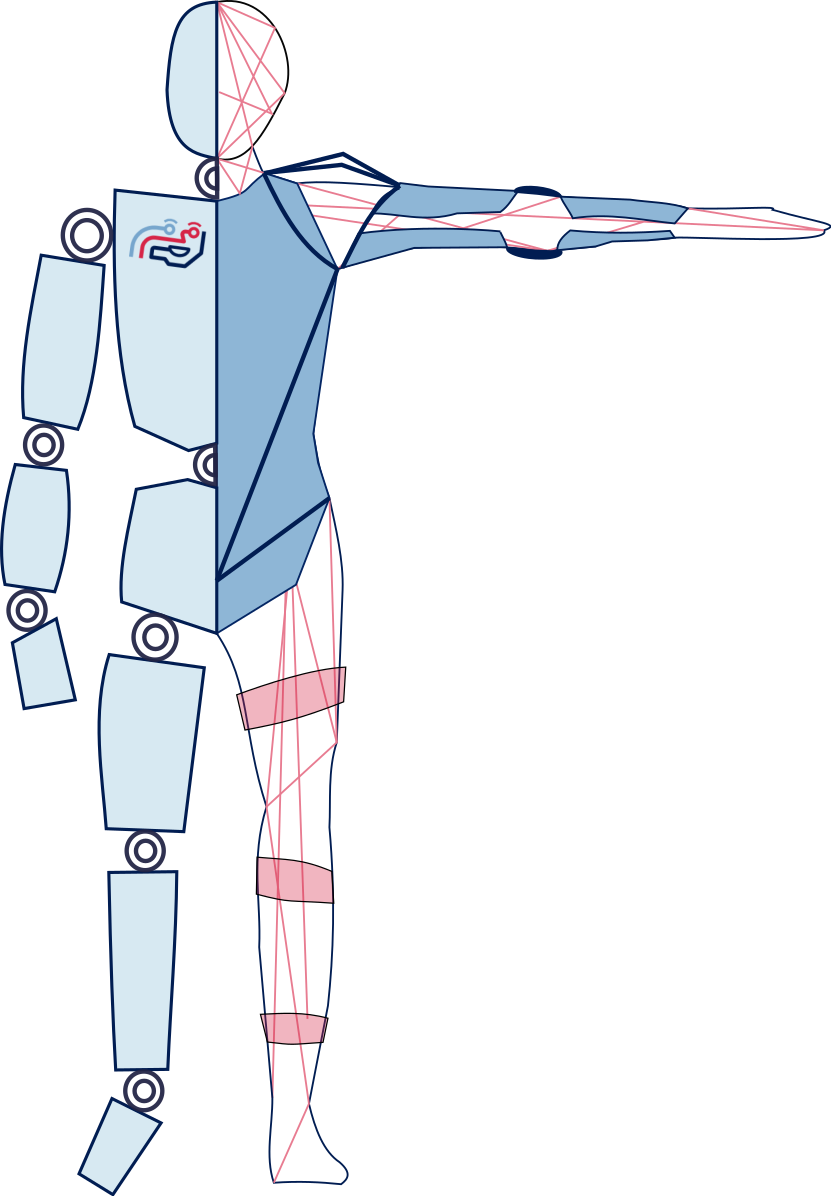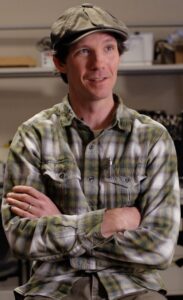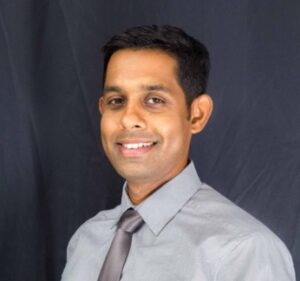Conor Walsh
Harvard University
John A. Paulson Harvard School of Engineering and Applied Sciences
Soft wearable robots for restoring performance after neurological and musculoskeletal injuries
This talk will give an overview of our work on developing soft wearable robot technologies for augmenting and restoring human performance and how we characterize their performance through biomechanical and physiological studies so as to further the scientific understanding of how humans interact with such machines. This talk will focus on particular applications of where inflatable soft robotics can be used to provide mechanical assistance to restore movement of reduced upper extremity for those with ALS and soft exosuits to improve mobility and lifting. A major focus will be on understanding specific challenges and use cases to drive the creation of wearable technologies that provide non-invasive solutions that have the potential to be rapidly translated to patients and end users.
Conor Walsh is the Paul A. Maeder Professor of Engineering and Applied Sciences at the John A. Paulson Harvard School of Engineering and Applied Sciences. He is the is the founder of the Harvard Biodesign Lab, which brings together researchers from the engineering, industrial design, apparel, biomechanics, physical therapy and business communities to develop and translate new disruptive robotic technologies for augmenting and restoring human performance. Example application areas include, enhancing the mobility of healthy individuals, restoring the mobility of patients with gait deficits, assisting those with upper extremity weakness to perform activities of daily living and preventing injuries of workers performing physically strenuous tasks. The soft exosuit technology is now commercially available in clinics for gait retraining through a collaboration with ReWalk Robotics and a lab spin-out, Verve, has launched a back assist product for workers performing physically strenuous tasks in industry. He is dedicated to training the next generation of biomedical engineering innovators and lab alumni have gone on to successful careers in academia, entrepreneurship, and high tech R&D positions in industry. Additionally, he co-founded the Soft Robotics Toolkit that serves as a platform the lab’s extensive STEM outreach activities. He is the winner of multiple awards including the Presidential Early Career Award for Scientists and Engineers and the MIT Technology Review Innovator Under 35 Award.
Matteo Bianchi
University of Pisa
Research Center E. Piaggio
Wearable haptics and human sensory-motor system modelling for advancing pHRI and human-machine interaction
Wearable sensing solutions have emerged as a promising solution for enabling unobtrusive and ergonomic measurements of the human muscular-skeletal system. However, the reconstruction performance of these devices strongly depends on the quality and the number of available sensors, which are typically limited by wearability and economic constraints. In this talk, I will show how prior information on the muscular and kinematic state can be fused with scarce and noisy time-series, following a Minimum Variance Estimation approach, and used for the definition of an optimization problem seeking for the most informative degrees of freedom (in terms of the minimization of the estimation uncertainty). I will discuss the theoretical foundations for the problem solution and provide practical translational outcomes, which include the design of wearable haptic devices for users’ ergonomics enhancement.
Matteo Bianchi is currently an Associate Professor at the Research Centre “E. Piaggio” and the Department of Information Engineering (DII) of the Università di Pisa. He is also clinical research affiliate at Mayo Clinic (Rochester, USA) and serves as co-Chair of the RAS Technical Committee on Robot Hands, Grasping and Manipulation and served as Vice-Chair for Information and Dissemination of the RAS Technical Committee on Haptics (2018-2021). His research interests include haptic interface and sensor design; human and robotic hands: optimal sensing and control. He acts as the Principal Investigator of national and EU grants, and research contracts with companies in the field of human-machine interaction. He is author or co-author of more than 140 peer-reviewed contributions and serves as member of the editorial/organizing board of international conferences and journals. He is the recipient of several national and international awards.
Jessica Allen
West Virginia University
Department of Chemical and Biomedical Engineering
How do humans successfully control balance during movement (or not)? Applications to wearable device design.
Moving about the world during daily life requires successfully executing and shifting between a variety of functional tasks. How the nervous system maintains balance while doing so involves a complex interplay between the neural, muscular, and skeletal systems. This talk will give an overview of our work investigating the neural control of balance during movement and its potential implications for the design of wearable assistive and rehabilitative robotics. I will highlight several examples in populations with either motor impairment (e.g., stroke survivors) or motor expertise (e.g., ballet dancers) that provide insight into mechanisms of motor action and perception that may be important to consider when developing wearable devices that aim to improve movement during daily life.
Jessica L. Allen is an Assistant Professor in Biomedical Engineering at West Virginia University, where she directs the Neuromechanics of Mobility Lab. She received her B.S. in Mechanical Engineering from the University of Florida, her Ph.D. in Mechanical Engineering from the University of Texas at Austin, and completed post-doctoral training in the neural control of movement at Emory University and Georgia Institute of Technology. Work in her lab aims to identify principles underlying the interaction between the neural, muscular, and skeletal systems that can inform interventional decisions to improve mobility and provide guidance for assistive and rehabilitative robotics.
Gregory Sawicki
Georgia Institute of Technology
Dept. of Mechanical Engineering and Dept. of Biological Sciences
Pushing beyond locomotion economy – What can exoskeletons do on the shortest and longest timescales?
The goal of the Human Physiology of Wearable Robotics (PoWeR) Laboratory is to discover and exploit key principles of locomotion neuromechanics in order to build wearable devices that can augment intact and/or restore impaired human locomotion. Performance goals include improving economy, stability and agility of human movement.
Over the last `5+ years, enabled by non-invasive dynamic ultrasound imaging, our lab has taken a deep dive ‘under the skin’ to reveal how exoskeletons can shift muscle-level contractile dynamics and improve locomotion economy. While reducing metabolic effort is an important use-case for exoskeletons, our muscle-level perspective has motivated a number of next questions that go beyond metabolic energetics including: How do exoskeletons impact sensory feedback? or Can exoskeletons improve balance recovery? and Can novel exoskeleton controllers using real-time, ‘muscle in the loop’ feedback shape in vivo muscle structure-function over long-timescales (e.g. months to years)? Along these lines, I’ll share some snapshots of our more recent work focusing on experiments to: (i) evaluate exoskeleton systems (e.g., hip) during unsteady locomotion, when balance is challenged and (ii) characterize long-term structure-function effects due to daily-use of wearable devices..
Dr. Gregory S. Sawicki is an Associate Professor at Georgia Tech with appointments in the Schools of Mechanical Engineering and Biological Sciences and the Institute for Robotics and Intelligent Machines (IRIM). Sawicki also spends part of his effort as a Senior Research Scientist at the Institute for Human and Machine Cognition (IHMC) in Pensacola, FL.
Dr. Sawicki directs the Human Physiology of Wearable Robotics (PoWeR) laboratory—where the goal is to combine tools from engineering, physiology and neuroscience to discover neuromechanical principles underpinning optimal locomotion performance and apply them to develop lower-limb robotic devices capable of improving both healthy and impaired human locomotion (e.g., for elite athletes, aging baby-boomers, post-stroke community ambulators).
By focusing on the human side of the human-machine interface, Sawicki and his group have begun to create a roadmap for the design of lower-limb robotic exoskeletons that are truly symbiotic—that is, wearable devices that work seamlessly in concert with the underlying physiological systems to facilitate the emergence of augmented human locomotion performance.
Bastien Berret
University Paris-Saclay
Movement vigor during human-exoskeleton interaction and the value of time
In daily life we usually move at a self-selected speed referred to as movement vigor. Understanding the underpinnings of movement invigoration has attracted a lot of attention in neuroscience. In the last decade, a cost of time theory stating that our brain is fundamentally sensitive to the passage of time during the control of goal-directed actions has emerged. Such a cognitive cost of time may have strong implications on the effectiveness and acceptability of assisting devices such as exoskeletons. These devices are often designed to decrease the user’s muscular effort but rarely consider the vigor they lead to and, therefore, tend to disregard the value of time in action control. In this talk, I will discuss the link between movement vigor and the cost of time within the framework of optimal control and illustrate the value of time in tasks where an energy-efficient but too slow assistance is provided to the user.
Bastien Berret obtained his PhD in applied mathematics and computational neuroscience in 2008 from the Université de Bourgogne (Dijon, France). In 2009, he joined the Italian Institute of Technology (Genoa, Italy) as a post-doctoral researcher in the Robotics, Brain and Cognitive Sciences department. In 2012, he was appointed as an Assistant Professor at the Université Paris-Saclay (Orsay, France). In 2017, he became a junior member of the Institut Universitaire de France (IUF). He is now a full professor in Human Movement Sciences at the Université of Paris-Saclay. His main research aims to better understand human motor control through modeling and experimentation, and to exploit this knowledge to improve control laws in applications involving robotic exoskeletons.
Massimo Sartori
University of Twente
Dept. of Neuromechanical Engineering
Towards Spatio-Temporal Modelling and Control of the Neuromuscular System
Neuromuscular injuries leave millions of people disabled worldwide every year. The impact of current assistive technologies is limited by the lack of knowledge of their physical interaction with the human body. Current assistive robots (e.g., robotic exosuits) do not consider how biological targets (e.g., joints, tendons, muscles, nerves) react to mechanical or electrical stimuli, especially at extreme ends of the spatiotemporal scale (e.g., tissue growth over days to months). This talk will outline current work conducted in my Lab to create a new framework for ‘closing-the-loop’ between wearable technology and human biology. My talk will show initial results on how bio-electrical recordings and numerical modelling can be combined to decode the cellular activity of alpha motor neurons in the spinal cord concurrently with resulting musculoskeletal forces at high resolution. The talk will show examples of how this paradigm can be employed in the context of wearable exoskeletons. In this context, we envision a new class of wearable systems that will be capable of delivering coordinated mechanical stimuli to alter, in a controlled way, biological tissue form and function, with broad implications in man–machine interfacing.
Massimo Sartori is Professor and Chair of Neuromechanical Engineering at the University of Twente, where he directs the Neuromechanical Modelling & Engineering Lab. His research focuses on understanding how human movement emerges from the interplay between the nervous system and the musculoskeletal system, both in healthy and impaired individuals. His overarching goal is to translate such knowledge towards the development of novel human-robot interfaces for restoring movement. On these topics Prof. Sartori is directing prestigious personal grants (e.g., European Research Council) as well as consortium-based research projects (e.g., H2020-MSCA-ITN, H2020-RIA-ICT).
Prof. Sartori obtained his PhD (2011) from the University of Padova (Italy) and was Visiting Scholar at the University of Western Australia (WA, Australia), Griffith University (QLD, Australia) and Stanford University (CA, USA). He conducted his main post-doc at the University of Göttingen (Germany) where he become Junior Research Group Leader in 2015. In 2017 he joined the University of Twente (The Netherlands) as a tenure-track scientist where he is currently leading an expanding research Lab. Throughout his career he received awards (e.g. NIH-NCSRR Scholarships, OpenSim Outstanding Research, UT’s Best PhD Supervisor), acted as editor as part of academic journals (e.g. IEEE TBME, Front Comput Neurosci), as well as organized leading congresses at the interface between biomechanics and robotics (e.g. IEEE BioRob 2018).
Prof. Sartori currently serves as an Associate Editor at the IEEE Transactions on Neural Systems and Rehabilitation Engineering as well as at Frontiers in Neurorobotics and Frontiers in Bionics and Biomimetics. He is a member of scientific societies including: the European Society of Biomechanics, the International Society of Biomechanics, the IEEE Robotics and Automation Society, the IEEE Engineering in Medicine and Biology Society, and the IEEE International Consortium on Rehabilitation Robotics.
Ashish Deshpande
University of Texas Austin
Walker Dept. of Mechanical Engineering
Harmony Exoskeleton: Ongoing Journey from Robotics Lab to Stroke Patients
Stroke is a leading cause of disability in the US and around the world, and the current rehabilitation treatments are costly, labor-intensive and insufficient, leaving millions of stroke survivors with life altering disabilities. Deshpande’s research group, the ReNeu Robotics Lab, deploys robotic tools for creating closed-loop interactions between the brain signals and physical behaviors with the goals of getting a deeper understanding of the impairments caused by stroke and developing novel interventions. Specifically, the group has developed a robot, called the Harmony Exoskeleton, for upper-body rehabilitation. Fundamental design and control advances have resulted in a number of features that make the Harmony Exoskeleton a suitable tool for delivering early-stage subject-specific treatment, for advancing the science of neuro-recovery and for assessing disability and recovery outcomes. The talk will discuss these key features and also the results from preliminary testing with stroke patients. It will also present some of the recent advances in the areas of robot control and machine learning for facilitating robot-mediated training of motor skills. The progress on the commercialization path toward bringing this rehabilitation robot in the hands to therapists to treat patients will also be presented briefly.
Ashish D. Deshpande is passionate about facilitating close physical interactions between the robots and humans toward tackling some of the biggest societal challenges, including improving rehabilitation after stroke and spinal cord injury, improving working conditions in the warehouses and factory floors, and reducing the negative impacts of menial but demanding jobs, e.g., janitors and nursing assistants. Over the years, his group has deeply studied the biomechanics, neuromuscular control of human system, and designed robotic systems that can safely interact with the humans and human-friendly environments. Specifically, his group has designed two novel upper-body exoskeletons and a number of novel robotic fingers and hands.
Dr. Deshpande grew up in India and received BE at VNIT, India, MS at UMass, Amherst, and PhD at University of Michigan, all in Mechanical Engineering. He is a faculty member in Mechanical Engineering at The University of Texas at Austin since 2011, where he directs the ReNeu Robotics Lab. Dr. Deshpande is a co-founder of Harmonic Bionics whose mission is to improve rehabilitation outcomes for the stroke patients
Leia Stirling
University of Michigan
Center for Ergonomics
Walking, thinking, and wearing an exoskeleton: Examination of exoskeleton interactions with human information processing
Exoskeletons have been proposed to augment, assist, and rehabilitate motion. The efficacy of an exoskeleton in supporting the designed goals is affected by how a person moves with and uses the exoskeleton. This fluency between the human operator and exoskeleton is affected by the alignment between dimensions of the person and exoskeleton, but is also affected by the manner in which the exoskeleton is integrated in the perception-cognition-action decision process of the operator. In this talk, I will highlight studies that examine the interactions between sensory perception, executive function, and motor action selection while wearing a lower-body active exoskeleton during goal-oriented tasks.
Leia Stirling is an Associate Professor in Industrial and Operations Engineering at the University of Michigan, a Core Faculty in the Center for Ergonomics, a Core Faculty in the Robotics Institute, an Affiliate Faculty in the Space Institute, and the University of Michigan Center for Occupational Health and Safety Engineering (COHSE) Director of Occupational Safety Engineering and Ergonomics. She received her B.S. (2003) and M.S. (2005) in Aeronautical and Astronautical Engineering from the University of Illinois at Urbana-Champaign, and her Ph.D. (2008) in Aeronautics and Astronautics from MIT. She was a postdoctoral researcher at Boston Children’s Hospital and Harvard Medical School (2008-2009), on the Advanced Technology Team at the Wyss Institute for Biologically Inspired Engineering (2009-2012), then an Assistant Professor at MIT (2013 – 2019). She joined the faculty at the University of Michigan in 2019. Her research quantifies human performance and human-machine fluency to assess performance augmentation, advance exoskeleton control algorithms, mitigate injury risk, and provide relevant feedback to subject matter experts across domains.







